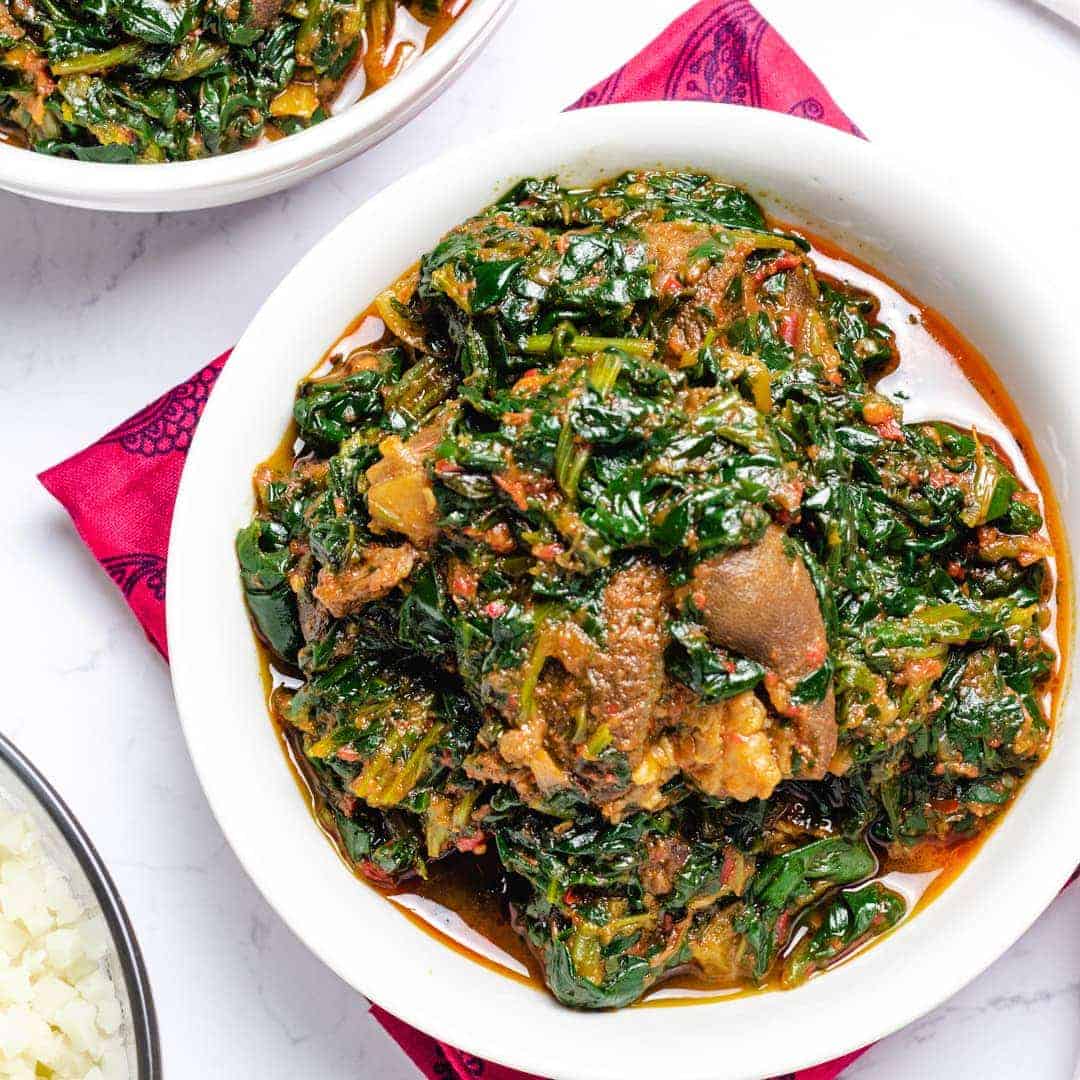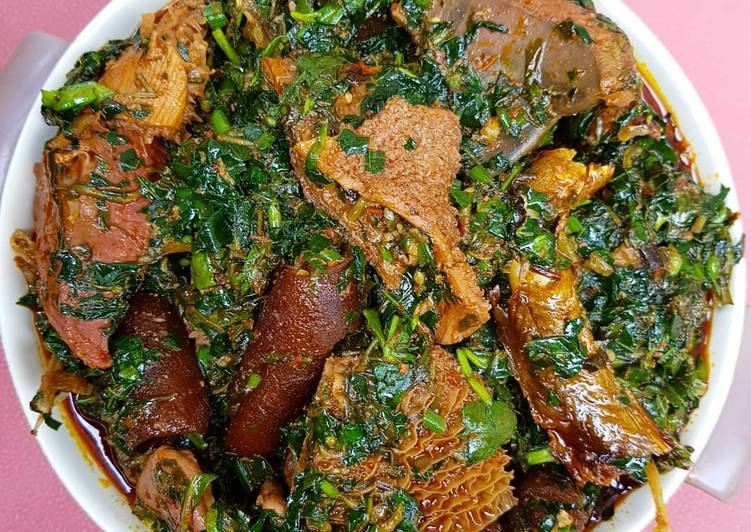
Efo Riro: A Classic Yoruba Delicacy

Efo Riro is a flavorful and nutrient-rich spinach stew that is a staple in Yoruba cuisine. Known for its vibrant colors and robust flavors, Efo Riro is made with a blend of vegetables, peppers, and assorted meats or fish. This dish is versatile, easy to prepare, and deeply satisfying, making it a favorite in many Nigerian households. Whether you're a seasoned cook or just beginning your culinary journey, Efo Riro is a dish that promises to delight your taste buds. The Cultural Significance of Efo Riro In Yoruba culture, food is more than just sustenance; it's a reflection of tradition, community, and identity. Efo Riro, which literally translates to "stirred leafy vegetable," is a dish that embodies these values. Often served during family gatherings, celebrations, and special occasions, Efo Riro is a symbol of togetherness and hospitality. It's a dish that brings people together, whether it’s served with pounded yam, amala, eba, or rice. Key Ingredients for Efo Riro The richness of Efo Riro comes from the combination of fresh vegetables, assorted meats, and a variety of seasonings. Below is a list of the essential ingredients you'll need to prepare this delicious stew: Fresh Spinach (Efo Shoko or Efo Tete): The main ingredient, spinach, provides the dish with its vibrant green color and earthy flavor. You can use other leafy greens like kale or collard greens if spinach is unavailable. Red Bell Peppers (Tatashe): These peppers add sweetness and color to the dish. Scotch Bonnet Peppers (Ata Rodo): Known for their heat, Scotch bonnet peppers give Efo Riro its characteristic spiciness. Tomatoes: Fresh tomatoes or canned tomato puree are used to create the base of the stew. Onions: Onions add depth and sweetness to the stew. Palm Oil: Palm oil is the traditional cooking oil used in Efo Riro, giving it a rich, reddish hue. Assorted Meats: Efo Riro is often prepared with a mix of meats such as beef, tripe (shaki), and goat meat. You can also add fish, especially dried or smoked fish, for extra flavor. Stockfish or Dried Fish: These add a unique umami flavor to the stew. Crayfish: Ground crayfish enhances the flavor and adds a distinct taste. Seasoning Cubes: Common in Nigerian cooking, seasoning cubes like Maggi or Knorr are used to boost the flavor. Salt: To taste. Locust Beans (Iru): Optional, but it adds a traditional flavor that's deeply rooted in Yoruba cuisine. Optional Ingredients: Prawns: Fresh or dried prawns can be added for additional flavor. Boiled Eggs: Some people like to add boiled eggs to Efo Riro, making it even more hearty and satisfying. Preparing Efo Riro Efo Riro is relatively easy to prepare, but like all great dishes, it requires a bit of patience and care. Here’s a step-by-step guide to making this Yoruba delicacy: Step 1: Preparing the Ingredients Wash the Spinach: Start by thoroughly washing the spinach leaves in cold water to remove any dirt or grit. After washing, chop the spinach into medium-sized pieces and set aside. If using frozen spinach, ensure it’s fully thawed and drained of excess water. Boil the Meats: In a large pot, boil the assorted meats (beef, tripe, goat meat) with seasoning cubes, salt, and half of the chopped onions. Cook until the meats are tender. You can add the stockfish or dried fish towards the end of the cooking process to soften them. Once done, remove the meats and fish from the stock and set them aside. Reserve the stock for later use. Blend the Peppers: Blend the red bell peppers, Scotch bonnet peppers, tomatoes, and the remaining onions into a smooth paste. This will serve as the base of your stew. Step 2: Cooking the Stew Heat the Palm Oil: In a large pot, heat the palm oil over medium heat. Allow the oil to heat up, but not to the point of smoking. If you’re using locust beans (iru), add them to the oil at this stage and fry for a minute to release their flavor. Fry the Pepper Mix: Add the blended pepper mixture to the palm oil and fry on medium heat. Stir occasionally to prevent burning. Fry until the oil starts to separate from the pepper mix, and the mixture has reduced to a thick paste. This process usually takes about 15-20 minutes. Add the Meats and Fish: Once the pepper mixture is well-fried, add the boiled meats and fish into the pot. Stir well to coat the meats in the pepper sauce. Add a bit of the reserved meat stock to the pot to loosen the sauce. Allow everything to simmer together for about 10 minutes so the meats can absorb the flavors. Add Ground Crayfish and Seasoning: At this point, add the ground crayfish and adjust the seasoning with additional salt and seasoning cubes if needed. Stir to combine. Step 3: Final Touches Incorporate the Spinach: Gradually add the chopped spinach to the pot. Stir continuously until the spinach is well incorporated into the stew. The spinach should wilt slightly but still retain its vibrant green color. If you’re adding prawns or boiled eggs, this is the time to do so. Simmer: Reduce the heat to low and allow the stew to simmer for another 5-7 minutes. This allows the spinach to fully absorb the flavors of the stew without overcooking. Serve Hot: Efo Riro is best enjoyed hot. It pairs beautifully with a variety of Nigerian staples like pounded yam, amala, eba, or rice. The combination of the richly flavored stew with the tender meats and fresh spinach makes for a truly satisfying meal. Tips for a Perfect Efo Riro Don’t Overcook the Spinach: The key to a great Efo Riro is ensuring that the spinach is cooked just right. It should be tender but still vibrant in color and full of nutrients. Balance the Heat: Scotch bonnet peppers are very spicy, so adjust the quantity based on your tolerance for heat. You can also remove the seeds to reduce the spiciness. Use Fresh Ingredients: For the best flavor, use fresh ingredients whenever possible. Fresh spinach, peppers, and tomatoes make a noticeable difference in the taste of the stew. Experiment with Proteins: While the traditional Efo Riro uses assorted meats, feel free to experiment with different proteins. Chicken, turkey, or even seafood can be great alternatives. Flavor the Oil: Frying the locust beans (iru) in palm oil before adding the pepper mix infuses the oil with a deep, earthy flavor that enhances the overall taste of the stew. Nutritional Benefits of Efo Riro Efo Riro is not only delicious but also highly nutritious. Spinach is rich in vitamins A, C, and K, as well as iron and calcium. The assorted meats provide protein and essential amino acids, while the palm oil, though high in calories, is a good source of vitamin E and antioxidants. The combination of these ingredients makes Efo Riro a well-rounded and nourishing meal. Conclusion Efo Riro is a classic Yoruba dish that showcases the rich culinary heritage of Nigeria. Its combination of fresh vegetables, hearty meats, and vibrant spices creates a stew that is both comforting and deeply flavorful. Whether you’re serving it at a family dinner or a special occasion, Efo Riro is sure to be a hit. So why not gather your ingredients, follow these steps, and bring a taste of Yoruba culture to your kitchen? Share the meal with loved ones, and enjoy the warmth and satisfaction that comes with every spoonful of Efo Riro.
